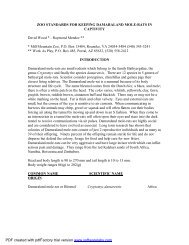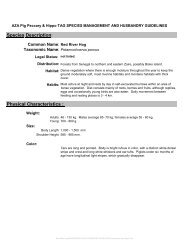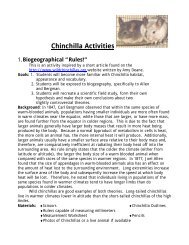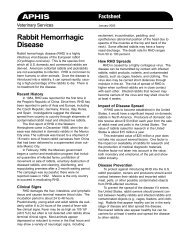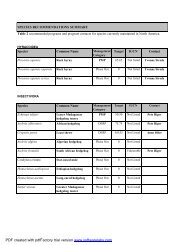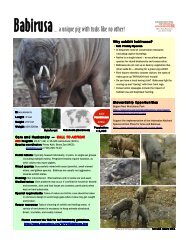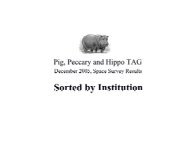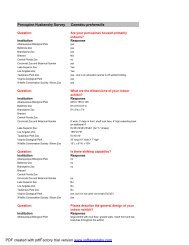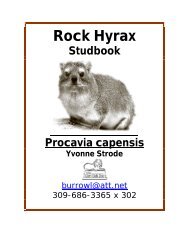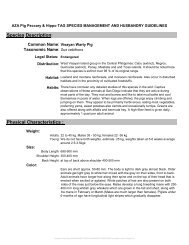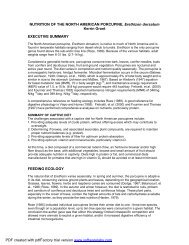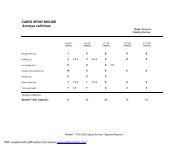Wild Boar Husbandry.pdf
Wild Boar Husbandry.pdf
Wild Boar Husbandry.pdf
- No tags were found...
You also want an ePaper? Increase the reach of your titles
YUMPU automatically turns print PDFs into web optimized ePapers that Google loves.
<strong>Husbandry</strong>Housing Requirements:Facility perimeter/barriers-Materials:Special Considerations:Substrate recommendations:Size of Exhibit:Rock moats and walls, recycled plastic stockade fence and chain link in concretefooting. Heigt should be a minimum of 5 ft.Animals should not be able to chew on or lift barriers.All substrates should be natural, cushion and be non-abrasive to animals feet, suchas mulch, grass or sandy soil.This can be subjective based on the group size and exhibit components. Animalsenjoy variety within the exhibit and room to run. For specific concerns pleaseconsult with San Diego Zoo.Temperature tolerances:Shade requirements:Can tolerate cool to cold temperatures. Will rest in mud wallows and seek outsprinklers or other water sources to cool off. Young animals require a heat source,besides bedding, if ambient temperature falls below 5C (40F).Needed to provide relief from direct sunlight during hotter portions of the year.Indoor/holding facilities:Materials:Size:Gate Recommendations:Multiple (1-1.2m wide) gates operated by pulley systems with the controls situatedin such a way that the caretaker is concealed and away from the entrance of theholding pen when trying to trap animals in holding. At least two holding pens arerecommended with several entrances and exits, creating a “round-about” allowingsubordinate animals to easily escape from dominant animals.Minimum size is 150 square feet per animal, adding at least 50 square feet for eachadditional animal.Rope or chain pulls/controls need to be out of animals’ reach or protected to preventanimals from having access to them.Daily Care and Maintenance:Water Delivery/Placement:Food Delivery/Placement:.Appearance of normal Feces:Standard livestock tanks, automatically refilling livestock drinkers etc, situated insuch a way as to minimize contamination, animals have a tendency to climb in andcontaminate drinker.Ground feeders, stock troughs. Feeders should have smooth surfaces. Multiplefeeding stations are recommended to prevent food-related aggression. Areasaround feeders should be kept clean to prevent excess ingestion of dirt.Greenish-brown, pelleted to slightly clumped.European <strong>Wild</strong> <strong>Boar</strong> MANAGEMENT AND HUSBANDRY GUIDELINES provided by San Diego Zoo
Hoof trim Requirements:Weight Measurement:Will vary depending on activity level and individual. Trim as needed duringchemical immobilizations. Hooftrims have been infrequent.Bar scales with platform on top, at the end of a corridor. Animals are moved to theplatform using a secure push board/door or using food incentives. Weights are alsotaken when a specimen has been crated and/or immobilized.Social Groupings: Several adult females with female offspring, and male offspring no older than 8-10months. An adult male can be introduced if the female(s) seem(s) receptive.However, the adult male needs to be separated from female group if one of thefemales is suspected to be pregnant.Behavior:The snout is used as a plow to move soil and uproot vegetation. The tusks aresometimes used to mark trees. Enrichment items can be used to lessen rootingbehavior.Reproduction:Sexual Maturity: For both sexes is 8-10 months, however, females generally do not mate until 18months of age. Males usually are not able to compete for mating privileges untilthey reach full size at approximately 5 years.Gestation:Breeding behavior:105-125 daysBreeding season is dependant on regional climate. In warmer climates, femalescan have several litters per year. Females have an estrus cycle of 21 days, arereceptive for 2-3 days and generally produce one litter annually.Parturition:Females:Birth of Young:Signs of: Increased girth, enlarged udder, distended vulva, pacing and restlessness.Nesting behavior will increase a few days before birth. Will be come less tolerant ofconspecifics.Usually 4-8 per litter. Young are born with light-colored longitudinal stripes whichfade and disappear between 4-6 months. Weaned after 3-4 months.Neonatal Care Preparations: Dam’s preparations: Provide sow with as much space as possible. Provide varioustypes of nesting material in adequate quantities to accommodate nesting behavior.Pine shavings or similar materials should be avoided, as they may clump ontoneonates and their mucus membranes.Keeper Preparations:Installation of “creep” (area only accessible to youngest offspring) or other methodto enable young to investigate and eat solid food undisturbed by adults or oldersiblings. Create low-stress environment, monitoring behavior of adults closely afterparturition; it is not uncommon for the dam to cannibalize her youngDiet:See attached diet sheets. Folivore biscuits can be used to train and reenforcebehaviors. Vegetables such as apples and bananas can be used to administermedications.European <strong>Wild</strong> <strong>Boar</strong> MANAGEMENT AND HUSBANDRY GUIDELINES provided by San Diego Zoo
Medical Concerns/Problems:Ivermectin is given, as per veterinary instructions, to reduce internal parasite load.Litterguard has been given to pregnant females, as per veterinary instructions, tovaccinate against E. coli in order to have antibodies passed on to offspring throughcolostrum. At about five weeks of age an exam is performed and the young receivea microchip for identification purposes. Weights are obtained and general health isdetermined. The animal is then returned to the mother as soon as possible. Theexam should be given far enough away so that the piglets cannot be heard by her.Transportation and handlingLevel of handling depends on amount of conditioning and desensitization animalhas been exposed to, as well as animal’s temperament. Otherwise chemicalimmobilization is recommended.Animals can be transported in well ventilated crates, singly and by group in alivestock trailer.European <strong>Wild</strong> <strong>Boar</strong> MANAGEMENT AND HUSBANDRY GUIDELINES provided by San Diego Zoo




